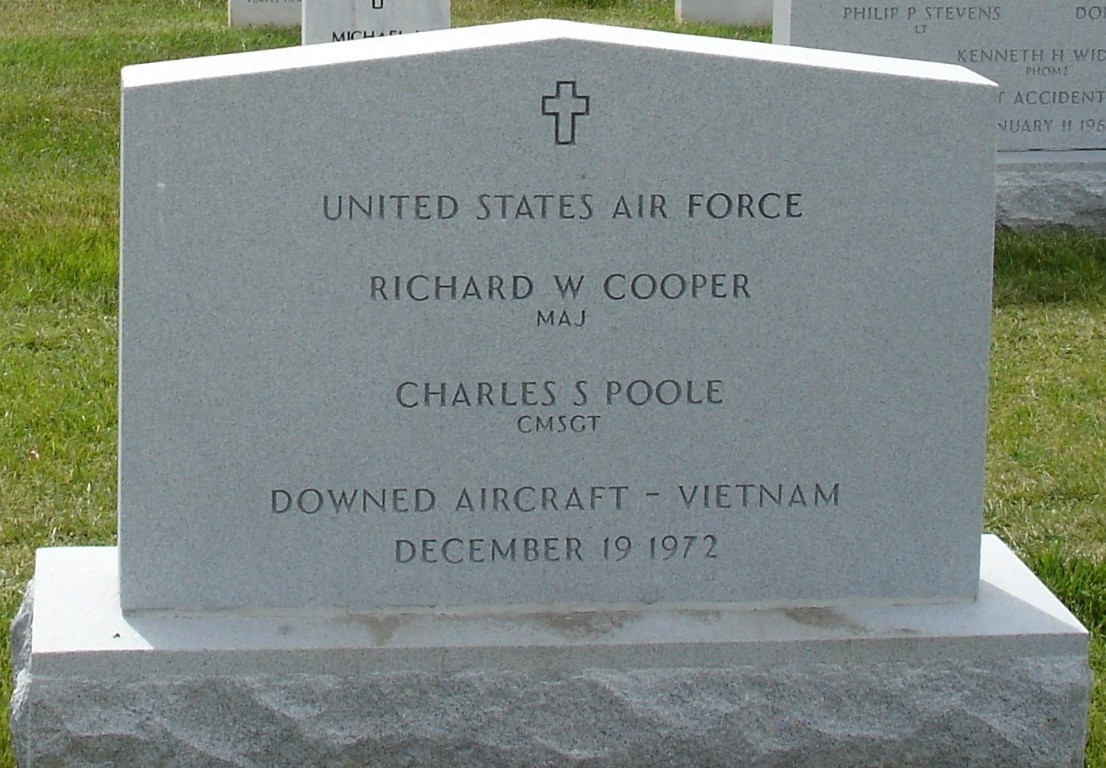No. 966-03
IMMEDIATE RELEASE December 19, 2003
Two Servicemen Missing in Action in Vietnam Identified
Two airmen missing in action from the Vietnam War have been identified and returned to their families for burial. They are Major Richard W. Cooper, Jr., of Salisbury, Maryland; and Chief Master Sergeant Charlie S. Poole, of Gibsland, Lousiana.
On December 19, 1972, Cooper and Poole were crewmembers aboard a B-52D Stratofortress bomber participating in the Linebacker II bombing of Hanoi, North Vietnam. Cooper was the navigator and Poole was the aerial gunner. At the completion of their bombing run, their bomber was struck by an enemy surface-to-air missile and crashed about six miles southwest of Hanoi. No other aircraft on the mission were able to establish emergency radio contact with the crew, and no parachutes were sighted. There was no search and rescue attempt mounted due to enemy control of the area.
It was subsequently learned that four of the crew had been captured and were being held as prisoners of war. Upon their release in 1973, they reported that Cooper had been unable to eject from the aircraft. Each of the surviving crewmen reported having seen only three other parachutes, thus accounting for all four survivors.
In 1993 and 1994, U.S. investigators of the Joint POW/MIA Accounting Command found photographs, records and artifacts in a Vietnamese military museum that correlated to the crashed B-52. Later in 1994, another U.S. team interviewed Vietnamese informants, visited a purported crash site, and determined that it was most likely the site of the B-52 loss. In the fall of 1995, a joint U.S.-Vietnamese team excavated the site where they found B-52 wreckage, crew-related items, personal effects and human remains. The crash site was so large that a second excavation was conducted in early 1996 when additional remains and personal effects were discovered.
Anthropological analysis of the remains by the Central Identification Laboratory, as well as mitochondrial DNA matches, confirmed the identification of these two men. Of the more than 88,000 Americans missing in action from all conflicts, more than 1,800 are from the Vietnam War.
Friday, December 19, 2003
Airmen Buried 31 Years After Vietnam Crash
Thirty-one years to the day their Air Force B-52 bomber was shot down over communist North Vietnam, the remains of two U.S. airmen were buried Friday at Arlington National Cemetery.
Major Richard W. Cooper, Jr., of Salisbury, Maryland, and Chief Master Sergeant Charlie S. Poole, of Gibsland, Louisiana, were crew members aboard the bomber when it was struck by a surface-to-air missile on December 19, 1972 after completing an attack mission over Hanoi. The plane crashed about six miles southwest of Hanoi.
Cooper was the navigator, and Poole was the aerial gunner.
No other aircraft on the mission was able to establish emergency radio contact with the crew, and no parachutes were sighted. A search and rescue attempt was not made because the plane went down in communist-controlled territory.
Four of the crew were captured and held as prisoners of war. When they were released in 1973, they reported that Cooper had been unable to eject from the aircraft.
In 1993 and 1994, U.S. investigators found photographs, records and artifacts in a Vietnamese military museum that correlated to the lost B-52. Later in 1994, another U.S. team interviewed Vietnamese informants, visited a purported crash site, and determined that it was most likely the site of the B-52 loss.
In 1995, a joint U.S.-Vietnamese team excavated the site and found B-52 wreckage, crew-related items, personal effects and human remains. The crash site was so large that a second excavation was conducted in early 1996 and additional remains and personal effects were discovered.
Anthropological analysis of the remains by the Army’s Central Identification Laboratory, as well as mitochondrial DNA matches, confirmed the identification of Cooper and Poole, the Pentagon said Friday.
Michael Robert Patterson was born in Arlington and is the son of a former officer of the US Army. So it was no wonder that sooner or later his interests drew him to American history and especially to American military history. Many of his articles can be found on renowned portals like the New York Times, Washingtonpost or Wikipedia.
Reviewed by: Michael Howard

